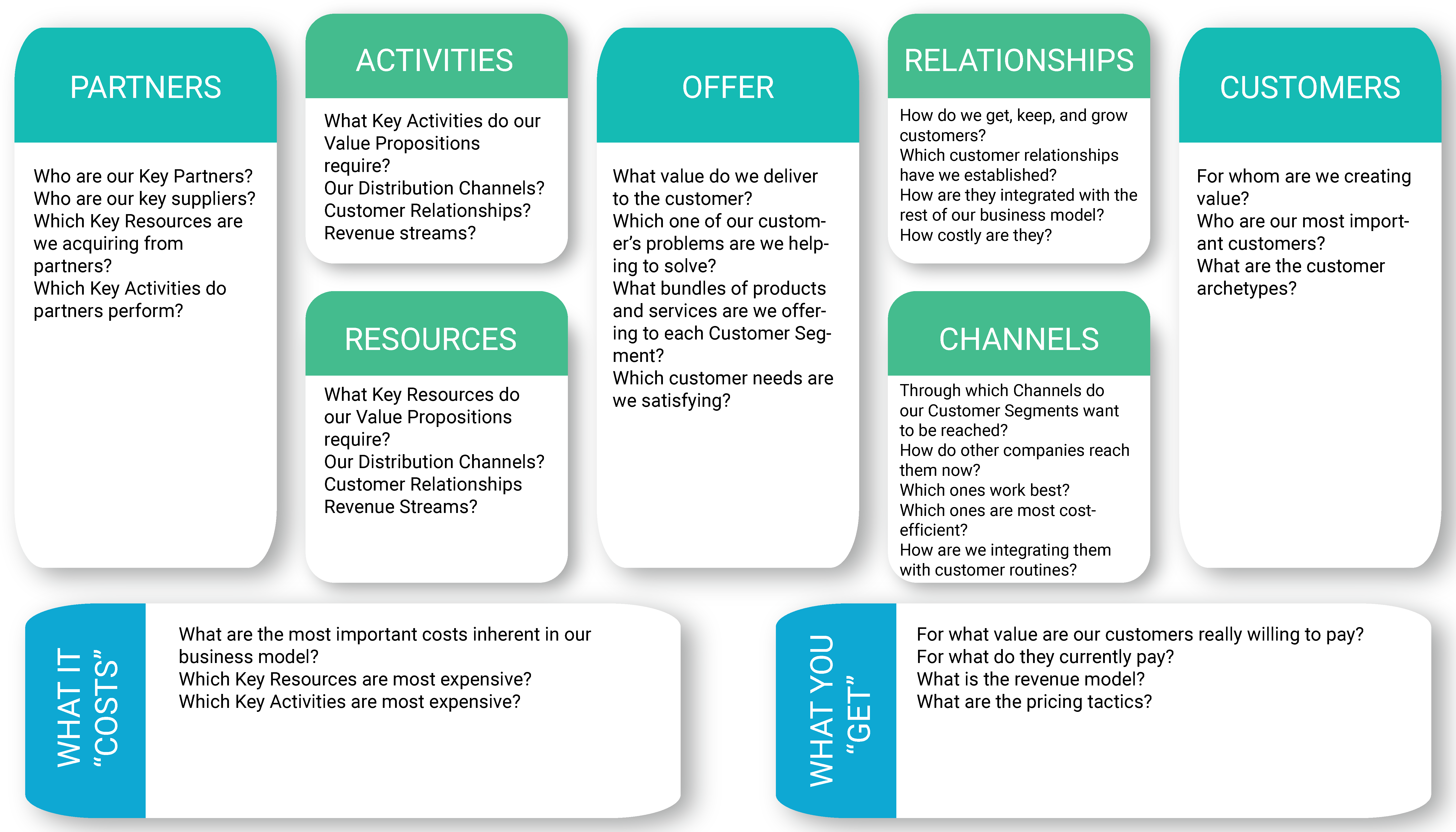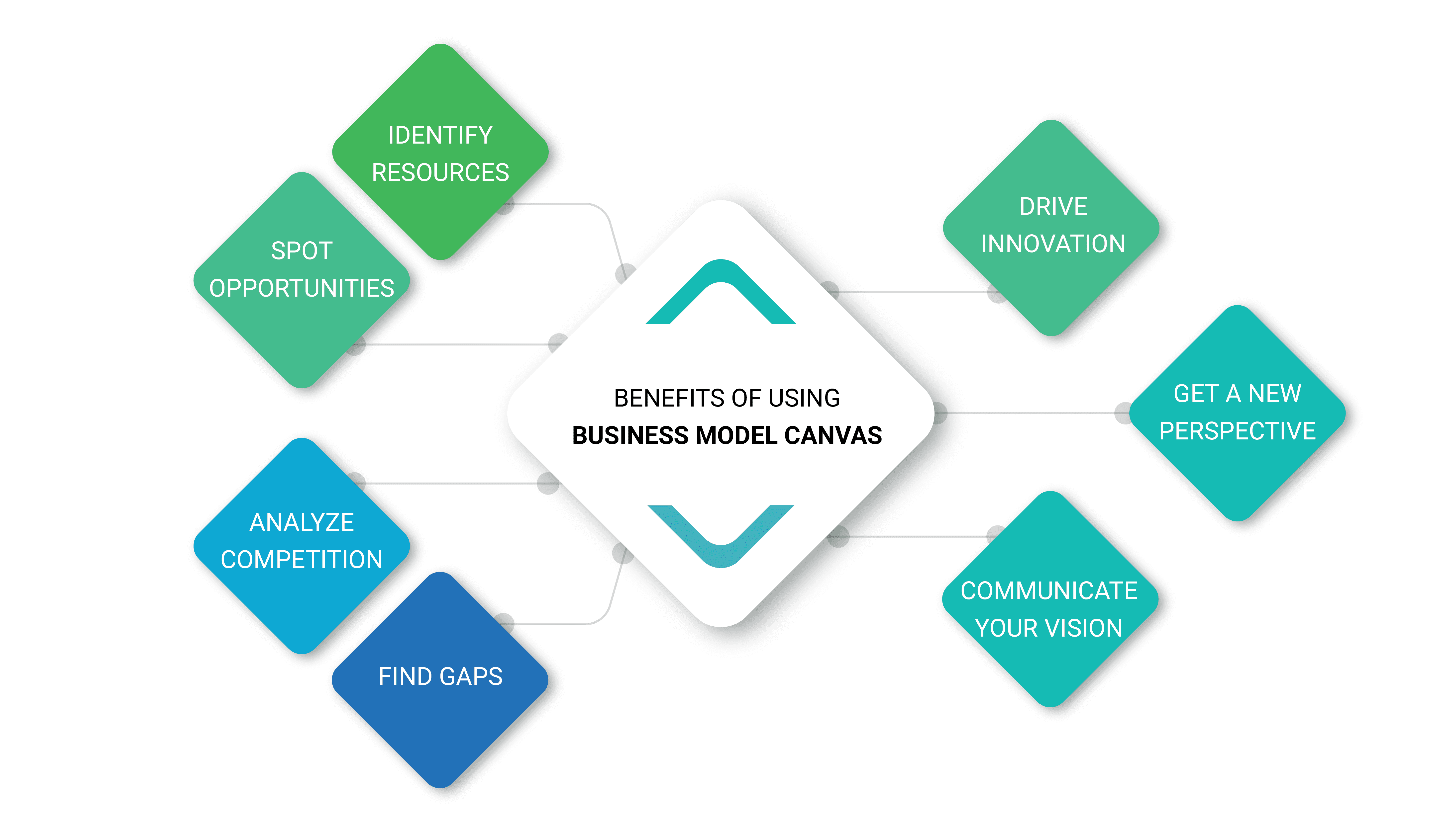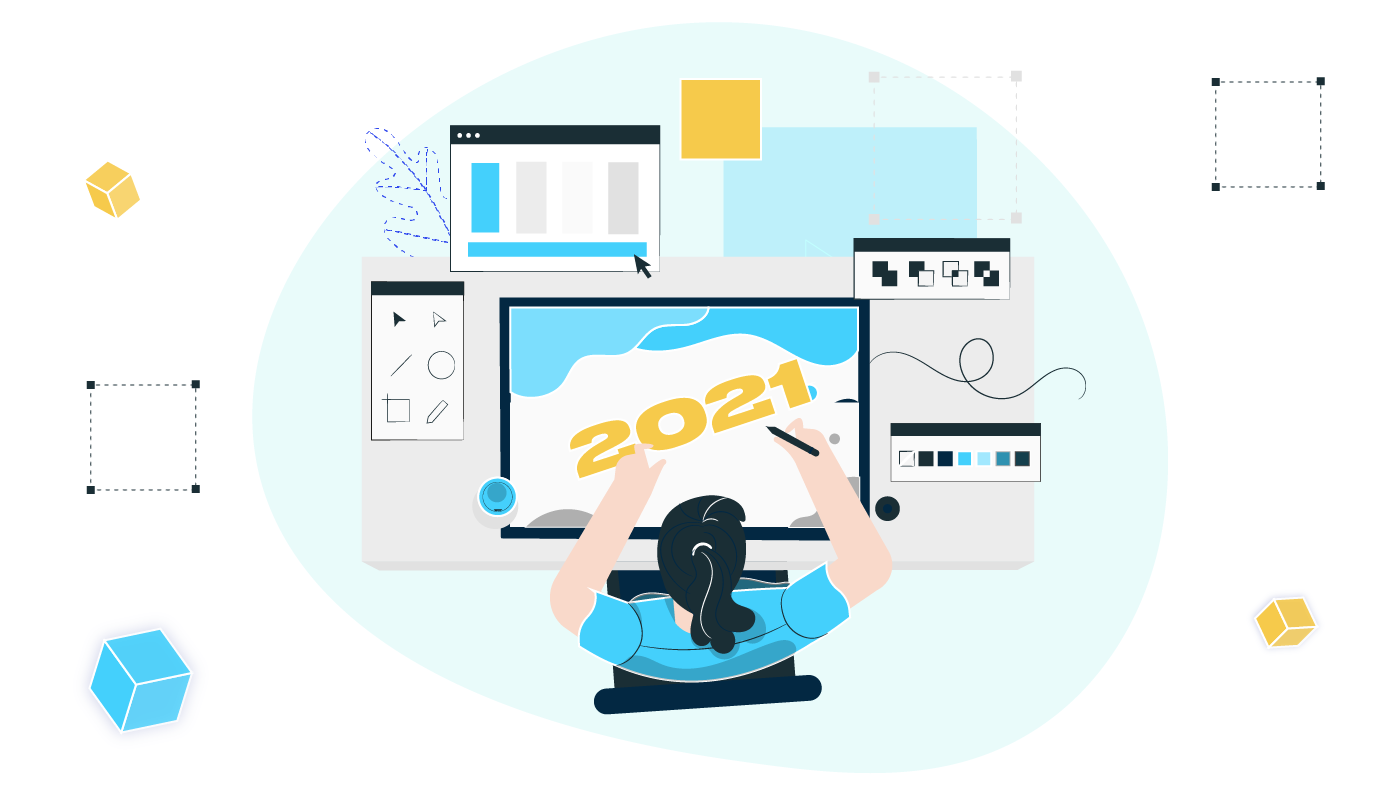Are you struggling to keep up in your field? Do you have problems with innovation? Are you unable to communicate your business concepts effectively? Then our Business Model Canvas guide will help you.
Before 2004, entrepreneurs had to struggle with drawing up complicated business plans. Then, Alexander Osterwalder introduced the Business Model Canvas (BMC) and changed the way companies approached planning.
The BMC is a layout that outlines the aspects of a business model. Osterwalder’s original canvas comprises nine elements, which we’ll discuss in more detail in this guide. These elements are the key to a company’s sustainability.
A solid business plan is critical to success, separating industry leaders from those who stumble. It serves as a roadmap for founders to navigate the market, raise resources, secure funding, and stay competitive. Without execution, even the most brilliant concepts can fail.
Still, creating a business plan can feel overwhelming for young entrepreneurs. Many find crafting a document daunting. This is where the Business Model Canvas proves invaluable. It’s a popular and efficient tool for presenting startups to investors, raising funds, formulating value propositions and identifying key resources.
In this article, we will explore the concept of the Business Model Canvas. We will give you tips on how to maximize its benefits for your company.
What is Business Model Canvas?
The business model canvas is a simple and convenient tool that helps organizations across all domains to acquire a helicopter view on their position on the market, define the direction for further development, create conversations between existing projects and analyze competition.
The story behind BMC goes back to 2000. When Alexander Osterwalder in his PhD thesis laid out the main principles of constructing a business model, he could not even imagine how many applications and manifestations it would receive.
Today, along with lean startup methodology, the business model canvas is applied in a variety of ways to provide up-and-coming companies, as well as large enterprises, with new insights.
Nespresso, a subsidiary of a multi-billion Nestle Corporation, is one of the numerous companies that successfully applied the business model canvas to restructure their business. The founders managed to turn a transactional retail business into a prosperous corporation involved in the distribution of Nespresso pods & coffee machines through direct channels. Once you buy a coffee machine from Nespresso, you appear to be locked in, which means you’ll have to buy Nespresso pods each time you want to make a drink. Interestingly, the total amount of money clients pay for pods might be 5 or 6 times more than they pay for a coffee machine. In such a way, the business model canvas helped the company to spot new opportunities, grow revenue, and bring it to a brand-new level.
Business Model Canvas vs Business Plan
In contrast to a traditional business plan, the business model canvas represents a simplified and structured overview of your company or project. The main difference between these tools lies in the way you present the data. Instead of wracking your brains over the structure, style of your document, and all the nitty-gritty details, draw and fill in the diagram to provide you and your stakeholders with a visual representation of your idea, value proposition, goals, aspirations, etc. Such a graph is easier to read both for you, your key partners, and investors, which means your chances of raising more funding are growing. Notable, the Scrum methodology also deserves to be among other productive frameworks. If you want to find out more about it, read on our blog.
9 Building Blocks of Business Model Canvas
Customers
No matter how innovative your product is, it is absolutely useless if your customers don’t need it. To find out who your target audience is, you have to conduct thorough market research or a set of experiments to see what social groups or types of businesses require your product the most.
Customer segments can be addressed in a variety of ways, depending on the industry you operate in. The first (traditional) approach allows you to categorize all clients based on their age, job description, gender, social status, size, etc. Pick up the criteria that are most relevant to your business and group your clients accordingly. The data for such type of segmentation can be sourced from your records, taken from your key partners or databases available online. Based on this information, you can develop a value proposition that would suit your target audience.
The second method is considered to be more innovative, yet sophisticated, as it offers to apply behavioral theory to segmentation. Understanding your clients’ social and geographical backgrounds is no longer enough. A new approach offers to group your clients based on behavioral patterns they apply when interacting with your product or service. The main objective is to develop new ways to address clients’ needs, gain new insights into their purchasing behavior, and optimize their journeys.
Value Proposition
Value proposition in the business model canvas is one of the most important steps as it helps you to see whether your product stands out and how it benefits its users.
If you’re reading this article, you probably have an excellent idea for your startup. Think of the value you are going to bring with your product and service and how it differs from others on the market. In such a way, you can take a “helicopter view” of your project and look at it from different angles.
During this phase, it’s important to pinpoint what makes your company stand out in terms of value propositions, your unique selling point (USP). What challenges do you excel at resolving for your customers?
Each value proposition consists of a range of products or services tailored to the needs of a buyer persona within your customer base. It’s where the offerings of your company intersect, with the motivations or impulses that drive customers to make purchases.
To identify your USP consider asking questions such as;
- What customer problem are you tackling?
- What goals are you assisting customers in achieving?
- How does your USP alleviate customer issues?
- Which products or services do you offer that target this specific problem area?
Let’s take Zara as an example. Why do individuals opt for Zara over its rivals? Zara’s key value propositions are quite clear. They provide clothing and accessories for men, women, and children at affordable prices.
There are two main value propositions, Zara highlights:
- Fast fashion: Zara regularly introduces clothing items and designs into its collections every 2-3 weeks both in stores and online. This approach keeps the brand up to date and contemporary, while also maintaining its budget pricing.
- Excellent customer experience: Zaras online shop offers a top-notch eCommerce experience featuring an easy to use interface. The customer categories are prominently displayed on the navigation bar. There’s also a search tool to elevate your online shopping journey.
Partners and Resources
These two blocks are brought to canvas to make you think over the implementation part. Running your company alone is impossible unless you own a small business.
Let us first take a look at the key resources. Key resources refer to the elements that add value to customers. These include property such as patents and trademarks, tangible assets such as factories and offices, and financial resources like initial startup capital.
Human capital is another resource to consider. Do you need software engineers or field sales teams? These are assets that require investment and should be integrated into your business model.
If your goal is to scale, you’ll definitely need a strong team and seasoned partners to support you in this process. Think over the following questions to fill out this section:
- What if your startup requires massive investment?
- Where are you going to find sources?
- Who or what can assist it in making your idea come alive?
If you can’t achieve your business objectives alone, you’ll have to find people or partners that will support you in this process and this section will definitely help you to decide which ones you need.
In today’s business environment, successful brands often use partnerships to expand the potential of their business models. These key partnerships can include joint ventures, non-equity strategic alliances and collaborations with buyers, suppliers and manufacturers.
A prime example of a partnership is the collaboration between ThePowerMBA and Forbes. Through this partnership we share expertise and content related to high level business education programs in exchange for visibility, among Forbes global audience.
Relationships
When you have your customers grouped into segments, you should decide how you’re going to interact with them. The importance of customer service is hard to overestimate: if you’re mistreated, no matter how cool the product or service is, you’ll never come back.
Thus, to attract new clients and retain existing ones, pay attention to details and identify the points of engagement between you and your prospects. You might draw a user journey graph to ensure clients interact with your product smoothly.
After acquiring customers, it’s vital to focus on building and strengthening these relationships. This can range from transactional interactions, such as those found on eCommerce platforms, like Amazon or Alibaba, to more personal relationships, such as those found in local businesses like a neighborhood bike store or bank.
Let’s take Zara as an example again. The brand’s customer relationships revolve around three elements that blend personal aspects:
- Interactions with salespeople at the store.
- Engagement with the brand in the media.
- Emotional attachment to products.
To begin with, customers can have an experience either in-store or online that is rather impersonal and could represent their interaction with the brand.
However, Zara encourages engagement through media platforms, particularly in the fashion industry. By maintaining communication channels, Zara allows its customers to interact with posts, images, and collections, which encourages a more personal connection.
This personalized approach to customer relations can naturally lead to the formation of brand advocates and communities.
In addition, over time, customers may develop a connection with garments or accessories from Zara’s collections, further strengthening brand loyalty through sentimental attachments to the products.
Channels
Channels in business model canvas are best defined as pathways which help your customers to find your product and become a part of your sales cycle. Have a look at your buyer personas, learn more about your clients’ behavior and identify the channels that would be relevant to your target audience.
For instance, if your product is targeted at teens, you’d better choose Snapchat as your main channel. The recent statistical research from emarketers has shown that this social network is the most popular among US teens, and it is expected to acquire 1.2 million 12-17 olds within the next two years.
If you’re new to BMC, there are a few questions that will help you to find the right channel:
- Who are your customers? What is their age, job description, social status?
- Which media do they use most often? What do research studies say?
- Where do they source information?
- Which sources do they trust the most?
- What events do they visit?
- What opinion leaders do they read?
Based on this information, you can choose the channel that will bring you the biggest value.
Activities
Key activities in the business model canvas are certain steps your company will undertake to create the value proposition for your clients. For instance, if you want to create a platform that would connect educators with learners, you’d probably need to make a design, choose a suitable monetization model, gain extra expertise, etc.
Some examples of key activities in business model canvas may include:
- Frontend & backend development
- Design creation
- Consulting
- Training planning
- Hiring
- Budget planning and so on
What It “Costs”
Cost structure involves all the expenses your company will incur while developing the value proposition for your customers. This section helps to set a realistic budget for your startup and decide whether to go ahead with your idea or “pivot”.
There are two ways you can approach cost structure: using a value-driven approach and based on cost optimization. The difference between the two lies in their names: while value-driven cost structures strive to provide more value to their customers, cost-based structures focus on minimizing expenses to create an optimal MVP. The choice of the approach is highly dependent on your position on the market and segment.
If you position your product as a “once-in-a-lifetime offer”, you’d better focus on value and strive to provide your customers with the highest quality. However, in case you have strong competitors, or you’re not sure about your idea, you’d better test waters before investing much money in development.
Revenue Streams in Business Model Canvas or What You “Get”
No business can exist without profit. Some companies are so focused on keeping their clients happy that they end up in red. It would help if you thought in what way you’re going to convert your product or service into financial gain and estimate its worth.
Revenue streams need to be defined as accurately as possible to develop a complete canvas. First, create a list of revenue sources and prioritize them accordingly. After that, you can go into details and run the numbers to come up with estimates. Specify the pricing of each source, list activities, and go through the lifecycle. This approach will help you decide whether to opt for a specific source or not. If the production or development cost is higher than what your clients are ready to pay, it’s always better to drop.

Benefits of Using Business Model Canvas
- Identify Resources. Business model canvas helps identify resources for the creation of your product. When you write a business plan, you might miss important points that are essential to your company.
- Spot Opportunities on the Market. The modern business world is fast-paced, so for any company, it is essential to get advantage of available opportunities quickly. If you linger, you might miss a chance to progress in your field.
- Analyze Competition. What does the market you operate in look like? Knowing competition beforehand will help you to stay prepared for the challenges and decide on your product’s features, positioning, and pricing strategy.
- Find Gaps. Are there any exciting opportunities on the market? Fill it with a revolutionary product or service that will grasp your customers’ attention. The BMC helps to see new opportunities that might be hidden from your rivals’ eyes.
- Drive Innovation. BMC provides you with a detailed market overview and leaves room for bringing new ideas to the industry.
- Get a New Perspective. Business model canvas can overhaul your view on the product and business model. It provides you with insights into your field, which can be applied in a variety of ways.
- Communicate Your Vision. In addition to a useful and innovative product, you should develop a communication strategy that you’ll apply to your clients and partner. BMC is helpful in this regard since it allows you to understand your customers and their values better.

Wrapping Up
Business model canvas is a tool that receives multiple applications across a variety of domains. It assists startups, as well as large corporations, in building their business strategy or helps to review an existing one. If handled well, it can provide you with essential knowledge of how to position your business, what steps to undertake, and which aspects to focus on at first. In such a way, you avoid the typical mistakes of startup founders and start your journey with a comprehensive business plan. If you need help with creating your business model canvas, our expert team is ready to help anytime. Contact us!





